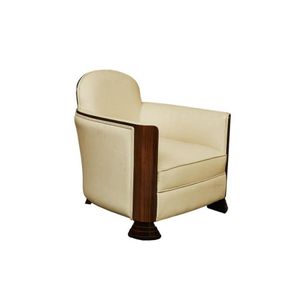Limed Oak Low Cabinet by O. Noel Coulson (1958)
You must be a subscriber, and be logged in to view price and dealer details.
Subscribe Now to view actual auction price for this item
When you subscribe, you have the option of setting the currency in which to display prices to $Au, $US, $NZ or Stg.
- Limed / Cerused Finish - A process for finishing timber whereby the surface was covered with a coating of lime, which was subsequently brushed from the surface, but allowed to remain in the grain. The resulting surface with its streaking and speckling of white was usually left unpolished. The finish was popular for French furniture in the late 19th century, and English cottage style furniture in the early 20th century. Oak timber was popular for liming because its open grain retained a larger amount of the lime than other close grained timbers.
Nowadays the same effect can be achieved by use of paint, or proprietry solutions for "liming". - Oak - Native to Europe and England, oak has been used for joinery, furniture and building since the beginning of the medieval civilisation. It is a pale yellow in colour when freshly cut and darkens with age to a mid brown colour.
Oak as a furniture timber was superceded by walnut in the 17th century, and in the 18th century by mahogany,
Semi-fossilised bog oak is black in colour, and is found in peat bogs where the trees have fallen and been preserved from decay by the bog. It is used for jewellery and small carved trinkets.
Pollard oak is taken from an oak that has been regularly pollarded, that is the upper branches have been removed at the top of the trunk, result that new branches would appear, and over time the top would become ball-like. . When harvested and sawn, the timber displays a continuous surface of knotty circles. The timber was scarce and expensive and was used in more expensive pieces of furniture in the Regency and Victorian periods.
This item has been included into following indexes:
Visually similar items

A. H. McIntosh teak sideboard, circa 1960s. In teak, with three central drawers, cocktail fittings to left side, length 201 cm, depth 49 cm, height 81.5 cm

Rosando Bros, parquetry inlaid teak sideboard, c.1960s with two tambour doors, slight damage to one door 80 x 200 x 55 cm

Schulim Krimper (Australian, 1893-1971), Sideboard, c. 1950, featuring four short drawers flanked by a pair of two door cupboards, two keys available, one key (A/F). Provenance: Private Collection, VIC. Other Notes: Cf. Terence Lane, Krimper, Gryphon, Melb

Pair of French Art Deco leather club armchairs, c. 1930, walnut frame, each upholstered in ivory leather with loose seat cushion (2), height 75 cm width 71 cm depth 78 cm. Provenance: Private Collection, Sydney
